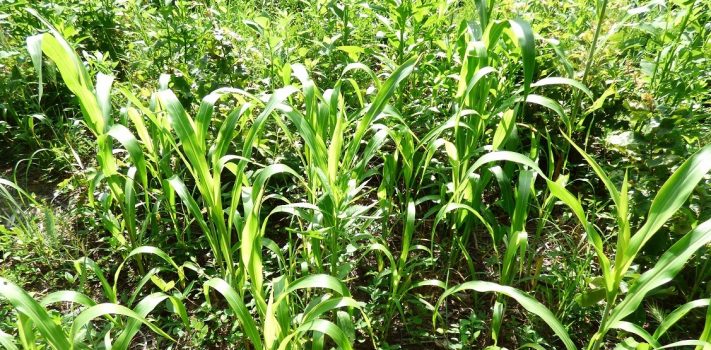(Continued from Part 1. This concludes the article.)
Most of your weeds will be annuals which must grow from seed each year and tend to be easy to deal with. My handful of “good weeds” grow large, are easy to pull up even when mature, and remain supple without getting too fibrous or woody making them excellent composting plants. An example is the perilla seen in Photo 5. This is my best composting weed so I let them get large (36”) as long as they’re not obstructing any crop plants. Others in this same category are most of the tender spring weeds which remain soft and never get very large such as henbit and chickweed, and are easy to pull up.
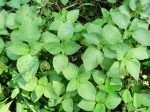
One critical reason to get to know your weeds is that some of them are toxic to certain animals including humans. The perilla I just mentioned can be fatally toxic to cattle, horses, and goats among others depending on the stage of the plant, so this is a topic worthy of research for those with animals. Other weeds such as the poison ivy I deal with every year have toxin properties which are not fatal but can cause severe skin and other bad reactions in some people. Do an internet search on poisonous plants in your area to find out which weeds to be wary of.
Other good weeds to be looking for are the edible and medicinal weeds. Many edible weeds taste like weeds (or worse) but some such as lambs quarter (Photo 6) are closely related to spinach and quinoa (all three in a group called chenopodiums) and for some of us they taste better than spinach. It’s so tasty I did selections over a three-year period to select for huge plants which were heavy seed producers. Do an internet search for medicinal plants in your area and you’ll find that some of them will be growing in your garden. Mullein and plantain are two of the more common medicinal weeds in my garden.
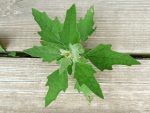
A few weeds will be perennials that come back from the roots even though you thought you removed them. These tend to be much more difficult to manage due to their strong root systems and some are prolific seed producers as well.
My worst emergency weed, nearly impossible to eradicate, is a perennial called buttonweed (Diodia virginiana, Photo 7). It’s very soft and supple, almost succulent, and makes good compost in its early stages. It goes into the compost pile as long as there are no seeds or flowers, then to the burn pile once they get to that stage.
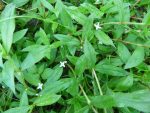
My second worst weed is a legume called lespedeza. The gnarly roots are extremely difficult to pull up making the plant nearly impossible to eradicate. When I first fenced off my garden, one corner was full of lespedeza. My only chemical-free option was to mow the area as short as I could, then put down old tarps covered with mulch. I planted squash in that area using individual grow boxes on top of the mulch. Two years later when I pulled up the tarps, the lespedeza was gone. Sometimes you have to go to these extremes to eradicate the worst weeds.
The last perennial I deal with is Johnson grass and its relatives. This is a very large bunchgrass and is difficult to mow and eradicate along fence lines. In the garden I use a shovel to dig it up and flip it over so the roots can dry out, returning later to shake off the dry soil before consigning them to the compost pile. Knowing which weeds can be pulled and which need a shovel can help eradicate perennial weeds much more quickly.
Get to know your weeds and be able to identify the perennials from the annuals.
Weed Seeds in the Compost Pile
Another aspect of getting to know your weeds is learning which ones to keep out of the compost pile. One of my most common weeds is a species of wild onion. I’ve tried cooking them all sorts of ways, even using the tender green shoots as chives, but they are so tough and stringy they have no use that I can discover. They multiply like crazy so when weeding, I begin by pulling all the wild onions and tossing them into the burn pile, then I pull the other weeds.
Conventional wisdom says not to put weeds into the compost pile which have gone to seed. “One year’s seeds equals seven year’s weeds,” is a nifty little rhyme but not especially useful for me personally. Weeds are ubiquitous and eternal so I ignore this advice for most annual weeds. There are so many other sources of weed seeds that I get more benefit from the compost than detriment from their seeds. Once the compost is tilled into the soil two years after the weeds were put into the compost pile, some of the seeds are no longer viable and after tilling, the percentage of seeds close enough to the surface to germinate is not enough for me personally to worry about. YMMV.
If you’re a normal gardener and don’t want weed seeds in your compost pile, learn when they go to seed so they can be pulled before that time. Many plants are day-length sensitive so will form seeds more or less the same week each year, letting you know to weed before then. One weed I don’t let go to seed I call Princess Anne (smaller relative of Queen Anne’s lace). The seeds annoyingly stick to my weeding gloves, pants and everything else.
One last thought on weeds in the compost pile. Since my area gets enough rain to keep the compost pile moist year round, some weeds continue growing after being tossed onto the pile. Perennials with runners or large root systems are especially prone to this. Perennial mints often have lots of runners so I let them dry down before adding to the pile. Some weeds have lot of soil sticking to the roots which is difficult to remove, but remember, all soil which goes to the compost pile will be returned to the garden when the composting cycle is over.
TOOLS FOR THE WAR ON WEEDS
Diamond Hoe – Also known as a scuffle hoe. I mentioned in another article on gardening that this is the single-most important tool in my weeding arsenal because it cuts way down on the amount of time it takes to weed. While a normal hoe must be raised into the air and then lowered again to get a single chop on weeds, a diamond hoe blade remains in constant contact with the soil so it’s more like scrubbing a floor with a mop. The hoe cuts weeds on both the push and the pull stroke so it’s very quick compared to a conventional hoe. The diamond-shaped head has points at the 3, 6, 9, and 12 o’clock positions. The longer right and left points allow you to slow down around the stems of your crops and very delicately hoe the weeds which you could never get with a conventional hoe, leaving less hand weeding afterwards. I got mine from Homestead Iron, a blacksmith who makes them right here in the U.S.A. and sells them at the Mother Earth News festivals and on his website, where he indicates they’re only for small weeds. This is not true. Depending on the species, I can cut some pretty large weeds on the pull stroke. I use mine all season long: like a mop in the spring, then with just the pull stroke later in the season on larger weeds. I highly recommend this tool, also available at other locations in slightly different variations, quality, and durability. The Homestead Iron hoe is also well worth the price because of the way the way the head is attached to the handle. We’ve all had rakes and hoes separate from the handle because they were pushed into a small thin tube with a bolt or rivet holding the head on, which eventually gives way. With Homestead Iron tools, the metal collar and heads are a single piece, attached to the hickory handle in such a way they should last for decades.
Leaf Rake – I was late to the party discovering leaf rakes as a garden tool. While growing up we only ever used a rock rake (which we always called a garden rake) in the garden. The trouble is, rock rakes also rake up a lot of soil with the hoed weeds. A leaf rake works much better for raking those finer weeds after they’ve ben hoed and can be turned so only a few tines are pointing down to get into the tighter areas. I’m now hunting at auctions for a narrower leaf rake with only five or six tines across. The cultivator I bought at my local hardware store also works for raking larger weeds.
Shovel – I’ve already mentioned a shovel for those really large-rooted perennial weeds, especially bunch grasses. Don’t procrastinate, dig them up as soon as you realize what they are before they get any bigger with a more extensive root system. For a hand shovel, nothing beats the rock-solid soil knife made by A.M. Leonard Company. It’s actually a small hand spade with the edges semi-sharpened. The stainless steel blade is very thick and durable, good for hand digging small tough perennial weeds and bunch grasses without bending.
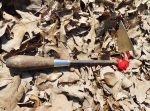
Hand Hoe – I have a triangle hand hoe (Photo 8) which I find indispensible in gardening and I probably use it for more jobs than all my other tools. The point is perfect for digging planting holes and furrows and when turned on edge, makes a good weeder for smaller or tighter areas. In Photo 9 you can see how I use this hoe for delicate weeding before putting mulch down on my cucumber rows. The top half of the photo is before weeding, the bottom after.
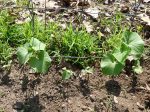
Tarp – A wheelbarrow or hand cart is the best way to get many weeds to the compost pile. An old tarp works wonders as well. I get tarps free from the hardware store which they take off bundles of lumber. Imagine trying to move enough leaves to mulch a large garden using a wheelbarrow. Since leaves are very bulky but lightweight, now imagine piling them all onto a tarp and dragging it over to the garden or compost pile. You can move a lot of leaves in a hurry. When getting leaves from my neighbors, I collect them on the tarp, then hoist the tarp up into the bed of my pickup to offload the leaves. The same principle works well for mulch-bound grass clippings which I let dry out for a few hours or overnight to make them lighter and easier to rake and move on the tarp.
CONCLUSION
I hope by now you’ve gained an appreciation of the importance of understanding your weeds before TEOTWAWKI Day One. Like gardening and composting, it’s a steep learning curve and you’ll have more failures than successes in the very beginning, but don’t give up. Failures are okay while supply chains are still keeping grocery shelves full but when the SHTF, these things will be critical knowledge that can make the difference between surviving and starving.
Imagine the amount of manual labor each of us will be doing in a grid-down world. Most of our non-sleeping hours will be filled with chores. Many survivors will spend way too much time weeding which could have been avoided had they gained some knowledge ahead of time. Weeding will be a vital task in that world where we must produce all our own food once the freeze-dried stroganoff runs out. The more efficiently we can be about weeding the more time we’ll have for firing up the generator and watching those Saturday-night Gilligan’s Island DVDs. Not only will knowing our weeds be important for proper management, but how to minimize them in the first place using various mulches.
[Disclosure notice: I receive no compensation for books and products mentioned in this article.]

